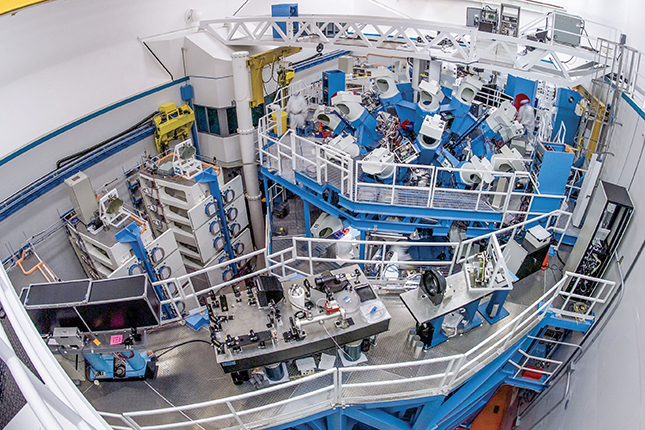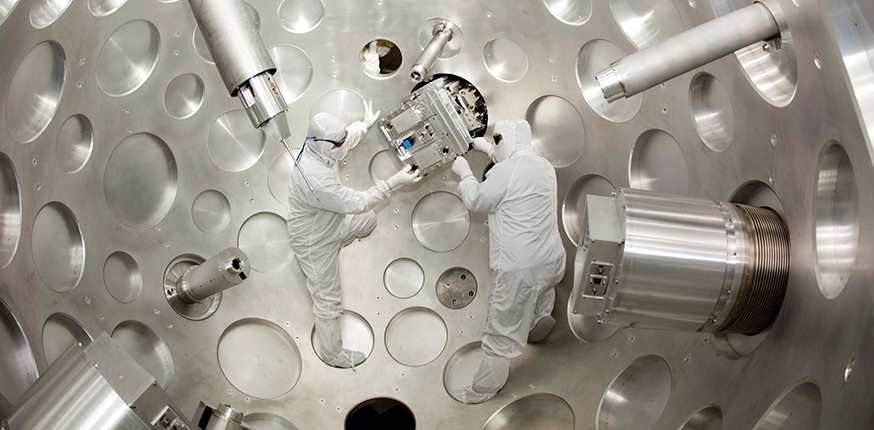Physicists decry cuts to inertial fusion program
DOI: 10.1063/PT.3.3895
Academic users of the University of Rochester’s Omega laser expressed alarm at the Trump administration’s proposal to close the device in three years; they warn that closure will devastate the growing field of high-energy-density (HED) physics and cripple the training of scientists who are required to maintain the nuclear weapons arsenal. The winding down of Omega is the most striking feature of a 20% proposed overall cut to the Department of Energy’s inertial confinement fusion (ICF) program for fiscal year 2019. The cut also entails a 70% reduction to ICF efforts to attain ignition, the point at which the fusion reaction becomes self-sustaining.
Roberto Mancini of the University of Nevada, Reno, who chairs the 400-member Omega users’ group, says that experiments on the laser cover topics such as laboratory astrophysics, radiation hydrodynamics, atomic and nuclear physics, materials and equations of state under extreme conditions, relativistic laser–plasma interactions, magnetized plasmas, and alternative fusion concepts. A news story

An overhead view of the University of Rochester’s Omega laser, looking toward the target chamber.
EUGENE KOWALUK, LABORATORY FOR LASER ENERGETICS

Making the necessary tradeoffs for higher priorities was the only response that Steven Erhart, then acting administrator of DOE’s National Nuclear Security Administration, would provide for the reductions to the budget. The FY 2019 NNSA budget proposes large increases in funding for weapons production and associated infrastructure. NNSA officials didn’t respond to several requests for further comment.
The administration’s FY 2019 budget blueprint, released on 23 February, provides $40.4 million for Rochester’s Laboratory for Laser Energetics (LLE), which houses Omega, compared with this year’s $66.8 million. The proposal also calls for terminating the $8.5 million krypton fluoride laser program at the US Naval Research Laboratory, also part of the ICF program, and ending the NNSA’s contract with General Atomics for ICF target fabrication. That work is funded at about $24 million.
The ICF program, whose budget next year would decline overall by $104 million, to $418 million, has long had laboratory-scale fusion as its main focus. But the program also serves to validate computer simulations of how materials behave at extreme pressures and temperatures, the conditions that occur during nuclear detonations and in stars. The program’s three major facilities—the National Ignition Facility (NIF) at Lawrence Livermore National Laboratory, Omega, and the Z pulsed-power accelerator at Sandia National Laboratories—each explore a different approach to inertial fusion. The ICF program is a component of the stockpile stewardship program, the combination of high-performance computing assets and experimental facilities that supplanted underground nuclear testing in the 1990s. (See “The Big Science of stockpile stewardship” by Victor Reis, Robert Hanrahan, and Kirk Levedahl, Physics Today, August 2016, page 46
“An existential threat”
The budget request would end direct NNSA support for stockpile-science workforce development in HED physics. That support had grown with the end of testing, in part as a means to attract new scientists into the weapons labs to replace the retiring workforce. The $9.5 million NNSA share of a basic research grants program in HED laboratory plasmas would be deleted. Graduate students who work on those projects often go on to work in the weapons program. DOE’s Office of Science is requesting $7.5 million for the basic science program next year, down from $10 million currently.
The budget proposal “is an existential threat” to HED physics, says Donald Lamb, a University of Chicago astrophysicist. (For a history of HED physics, see the article by Paul Drake, Physics Today, June 2010, page 28
Lamb, who has served on numerous advisory committees to the weapons labs, warns that without the expertise to carry out experiments that can validate computer simulations, the labs can’t be confident that any changes or replacements made to nuclear weapons will work as expected.

Technicians inside the Omega EP target chamber at the University of Rochester perform initial installation. The Omega EP laser came on line in 2008 and is outfitted with a large suite of diagnostics compatible with the Omega target chamber.
EUGENE KOWALUK, LABORATORY FOR LASER ENERGETICS

“If you cut off the students and the young talent, they are going to be gone,” says Richard Petrasso, head of the HED physics division at MIT’s plasma science and fusion center. His program currently has six PhD students who are working on experiments at Omega, and four of them have also done work at NIF. About 90% of the graduate students that have earned their doctorates in HED physics from MIT have been supported by NNSA, he says.
Petrasso’s students have invented multiple diagnostics for the ICF program. Seven of those have been adapted for use at NIF, including one that he describes as “like a flashbulb done with monoenergetic particles” that backlights experiments. “You’re talking about people who have the capability to understand nuclear weapons and make assessments. In this world, you have to have people who are capable of that,” he says.
Carolyn Kuranz, project director of the Center for Laser Experimental Astrophysical Research at the University of Michigan, creates and studies laboratory-scale HED plasmas at Omega in regimes similar to those found in supernovas and accretion disks. “A lot of the work I and my students do there has a huge impact on national security,” she says. “I don’t know where students would get their training or how they would even hear about the field” if Omega were closed, she says. She adds that the US would quickly be overtaken in the field by China and Europe, which are building similar facilities. France’s much larger Laser Mégajoule, for example, is starting operations.
John Soares, senior scientist at LLE, says the NNSA has supported 40 graduate students at Rochester each year at Omega, typically for five years. A separate grants program run by LLE supports 25–35 graduate students from other institutions to work at the lab each year.
Although considerably smaller than NIF—30 kilojoules from 60 laser beams versus 1.8 megajoules from 192 beams—Omega’s much faster repetition rate, lower operating costs, and unclassified setting allow for a far greater number of experiments. Omega can be fired up to 15 times a day, compared with NIF’s maximum three shots a day. And at NIF, only 18 days a year are reserved for nonweapons experiments. Although very few classified experiments are performed at Omega, many are relevant to weapons physics, says Michael Campbell, LLE director.
Omega was built in 1995. A separate four-beam laser and target chamber known as Omega EP were added in 2008. They can also be operated in a joint mode to irradiate targets in the same chamber. In one such experiment, the EP has been used to perform x-ray radiography on targets as they are imploded by the larger laser.
Campbell says about 60% of the 2100 experiments on Omega each year are performed by users from outside Rochester. About 300 are done by researchers from universities in the US, Europe, and Japan. Others are conducted by national lab scientists. Much of Omega’s research is in support of NIF: Livermore scientists perform more experiments on Omega than they do on NIF, and the protocol for plutonium experiments at NIF was developed at Omega with surrogate metals.
Supervision lacking
The FY 2019 budget proposes to suspend research on the direct-drive approach to ICF. That’s the method of implosion at Omega, where lasers are focused to impinge directly on capsules of fusion fuel. Ending that avenue of research would short-circuit the reassessment of the ICF alternatives that was previously planned to start in 2020 (see “NIF may never ignite, DOE admits
Experiments at NIF have focused on indirect drive. In that approach, beams are sent into a cylinder that houses the fuel capsules, producing x rays that drive the implosion. When NIF was completed in 2009, program managers were confident they could create ignition by 2012. That milestone has yet to be attained.
At NIF, the budget would fall by $57 million next year, to $287 million, which would force a 30% reduction in the number of shots. Facility director Mark Herrmann says the cuts at NIF would be “a real blow to everything we do for stewardship, but the ignition effort will slow down drastically or possibly stop.” The reductions would come at a time when progress continues toward ignition, he says, as fusion yields obtained at NIF have doubled in the past year or so.
Worsening the budget picture for both NIF and Omega is the absence of NNSA funding for target fabrication by General Atomics. The labs would have to absorb those costs—about $16 million at NIF and $8 million at Omega.
The third ICF facility, Sandia’s Z, would see its funding rise from last year’s $110 million to $118 million, but only because it gets nearly half of its funding from non-ICF weapons science programs. The ICF share would fall from $63 million to $57 million.
The ICF cuts are proposed in an NNSA FY 2019 request that includes a $1.8 billion increase, to $11 billion, for all nuclear weapons activities. The proposed increase is mainly devoted to extending the lifetimes of three warhead systems and to accelerating capital improvements and overdue maintenance to the aged weapons production complex.
Two sources familiar with the program suggested the ICF cuts were due in part to the absence of a deputy NNSA administrator for defense programs. The position has been vacant since President Trump took office.
The White House announced on 26 February the nomination of Charles Verdon, currently principal deputy administrator for weapons and complex integration at LLNL, to the NNSA deputy administrator post. Commenting on the proposed cuts to ICF a few days prior to his nomination, Verdon told a reporter that the labs hadn’t done enough to educate other NNSA officials about the importance of the program.
It’s unlikely that the proposed cuts to the ICF program will survive the congressional appropriations process intact. Members of New York’s delegation have declared they will fight the move to shut down LLE. “Turning out the lights on Rochester’s laser lab is a horrible plan,” Senator Charles Schumer (D-NY) said in a statement. “It would not only slash [the jobs of] the 340 high tech engineers and scientists who work there, but it would jeopardize the safety, security, and reliability of our nation’s nuclear weapon arsenal. Simply put, I will do everything possible to prevent the administration’s wrongheaded effort.”
Similar statements showing bipartisan support were issued by New York Representatives Louise Slaughter (D) and Chris Collins (R).
More about the Authors
David Kramer. dkramer@aip.org
